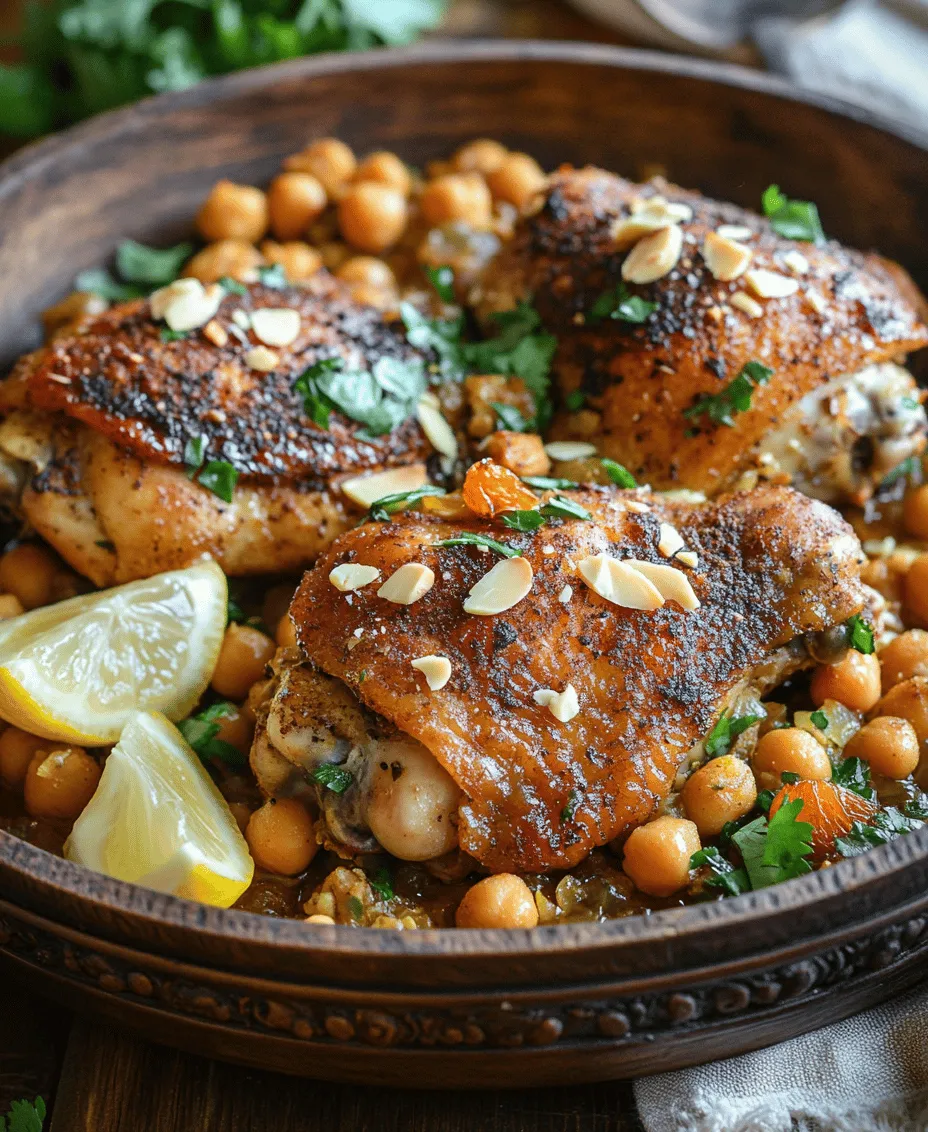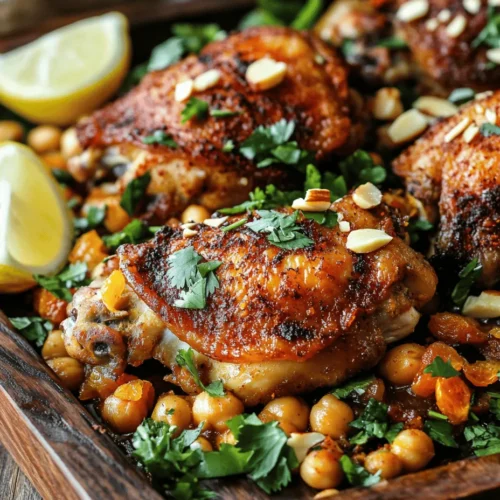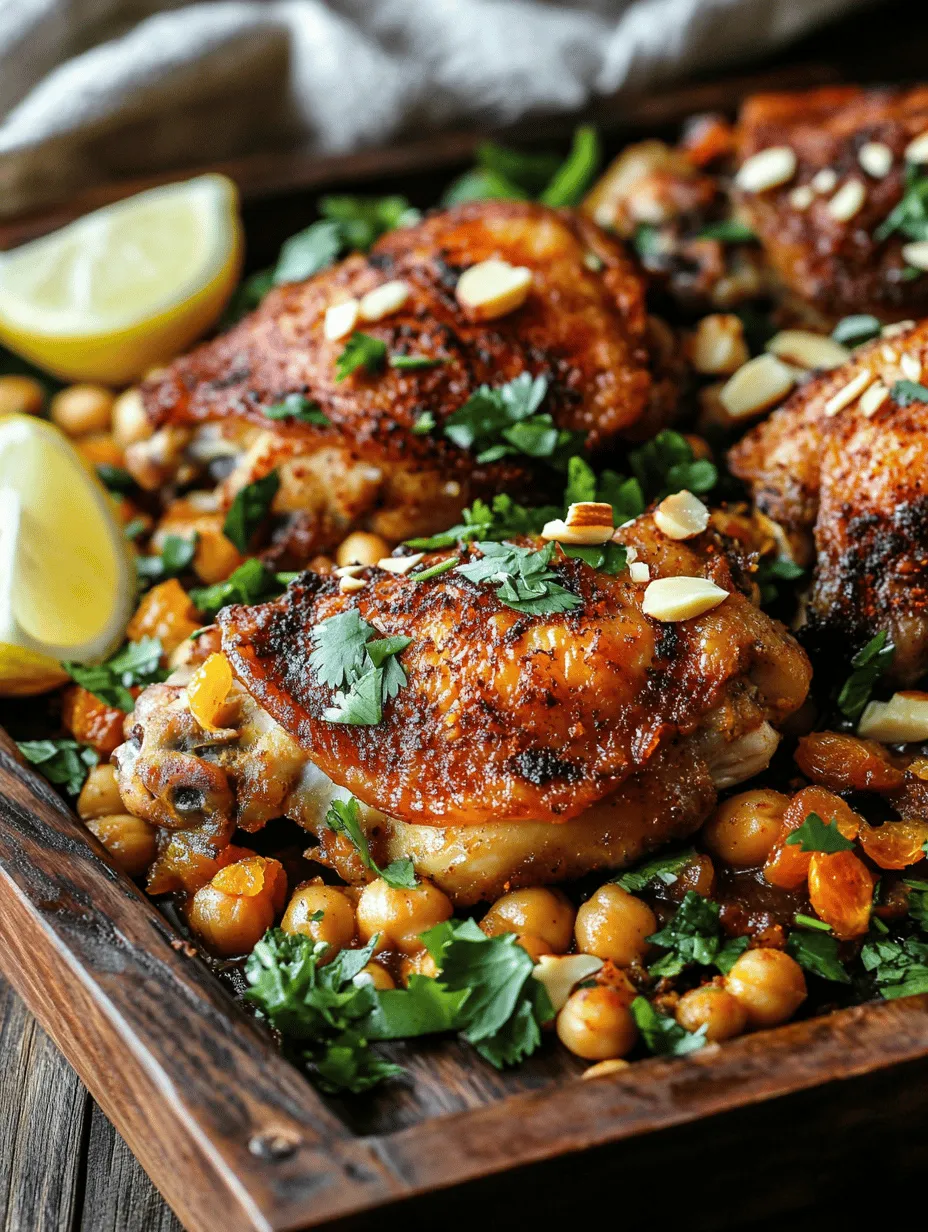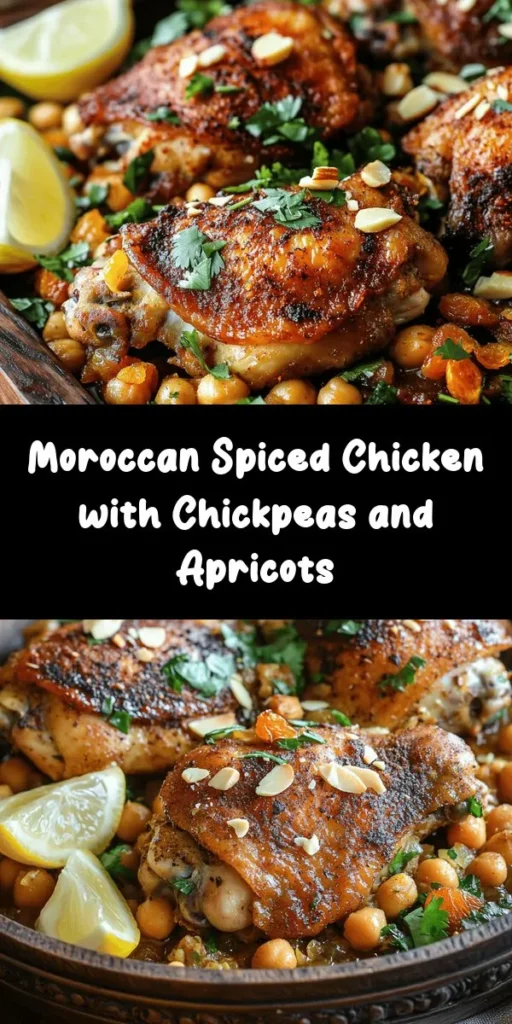Introduction
In the world of culinary delights, few cuisines can transport you to another realm quite like Moroccan cuisine. Known for its vibrant flavors, aromatic spices, and rich ingredients, Moroccan dishes offer a unique dining experience that excites the palate. One such dish that stands out is Moroccan Spiced Chicken, a perfect blend of savory and sweet elements that can easily become a family favorite. This article provides a detailed exploration of this recipe, breaking down the ingredients, cooking techniques, and the cultural significance behind the dish, ensuring you can recreate this delightful meal in your own kitchen.
Understanding Moroccan Cuisine
The Essence of Moroccan Flavors
Moroccan cuisine is a vibrant tapestry of flavors and aromas that reflects its rich history and diverse cultural influences. At the heart of this cuisine is the careful balance of spices and herbs, which create layers of flavor in every dish. The use of spices such as cumin, coriander, cinnamon, and saffron is quintessential to Moroccan cooking, offering both warmth and depth. These spices not only enhance the taste but also contribute to the dish’s visual appeal, transforming ordinary ingredients into extraordinary culinary creations.
A hallmark of Moroccan dishes is the interplay between savory and sweet flavors. Ingredients like dried fruits, honey, and nuts are often combined with meats and vegetables, creating a harmonious balance that excites the senses. Moroccan Spiced Chicken embodies this essence, combining tender chicken thighs with a medley of spices, sweet apricots, and crunchy almonds. This dish not only satisfies hunger but also tells a story of a rich culinary tradition steeped in history and culture.
Cultural Significance of Spices in Morocco
Spices hold a special place in Moroccan culture, transcending their culinary uses to become symbols of hospitality, celebration, and tradition. Historically, Morocco was a central hub on the spice trade routes, drawing merchants and travelers from various regions. This cultural exchange introduced a plethora of spices that have become integral to Moroccan cooking.
In Moroccan households, spices are often used to celebrate special occasions, from family gatherings to religious holidays. The act of preparing food is seen as a communal effort, with families coming together to blend spices and create mouthwatering dishes. Moroccan Spiced Chicken, with its aromatic blend of spices, is frequently served during festive occasions, symbolizing warmth and hospitality.
The importance of spices extends beyond their flavors; they are also believed to have health benefits. Many Moroccan spices are rich in antioxidants and possess anti-inflammatory properties, which adds another layer of appreciation for their use in traditional cooking.
Ingredients Breakdown for Moroccan Spiced Chicken
Essential Ingredients Overview
To create a truly authentic Moroccan Spiced Chicken, selecting the right ingredients is crucial. Each component plays a unique role in crafting the dish’s signature flavor profile. Here’s a closer look at some of the essential ingredients:
1. Chicken Thighs: The star of the dish, chicken thighs are preferred for their rich flavor and tender texture. Unlike chicken breasts, thighs remain juicy even after cooking, making them ideal for marination and longer cooking times.
2. Olive Oil: A staple in Mediterranean cooking, olive oil adds a depth of flavor and helps to tenderize the chicken. Its heart-healthy fats contribute to a moist and succulent dish.
3. Garlic: Fresh garlic is essential for building flavor. Its robust aroma complements the spices, enhancing the overall taste of the chicken.
4. Spices: A blend of warm spices such as cumin, paprika, cinnamon, and turmeric brings the Moroccan flair to the dish. Each spice adds its unique profile, creating a complex flavor that is both comforting and exotic.
5. Chickpeas: These legumes add a hearty element to the dish, providing protein and texture. Chickpeas absorb the spices beautifully, becoming a flavorful addition to the chicken.
6. Dried Apricots: The sweetness of dried apricots balances the savory spices, contributing to the dish’s signature sweet-savory flavor. They also add a chewy texture that contrasts beautifully with the tender chicken.
7. Almonds: Toasted almonds provide a satisfying crunch and nutty flavor, enhancing the dish’s overall texture and richness.
The Importance of Freshness and Quality
When it comes to cooking, the quality of the ingredients can make a significant difference in the final dish. For Moroccan Spiced Chicken, using fresh, high-quality ingredients is paramount. Fresh chicken thighs, vibrant spices, and ripe fruits will not only enhance the flavor but also improve the texture and presentation of the dish.
When selecting spices, opt for whole spices whenever possible, as they retain their potency longer than pre-ground varieties. Grinding spices just before use will release essential oils and aromas, providing a fresher taste. Additionally, sourcing organic or locally grown vegetables, fruits, and herbs can elevate the dish, making it not only delicious but also more nutritious.
Marinating the Chicken: The Key to Flavor
The Science Behind Marination
Marination is a culinary technique that involves soaking food in a seasoned liquid before cooking. This process serves several purposes, most importantly enhancing flavor and tenderness. For Moroccan Spiced Chicken, marination allows the spices to penetrate the meat, resulting in a deeply flavored dish that tantalizes the taste buds.
The science behind marination lies in the interaction between the acidic components (such as lemon juice or vinegar) and the proteins in the chicken. Acidic marinades help to break down muscle fibers, making the meat more tender. Additionally, the salt in the marinade draws moisture into the chicken, ensuring it remains juicy during the cooking process.
Step-by-Step Marination Process
To achieve maximum flavor absorption, follow these step-by-step instructions for marinating the chicken:
1. Prepare the Marinade: In a mixing bowl, combine olive oil, minced garlic, and your chosen spices (cumin, paprika, cinnamon, turmeric, salt, and pepper). For added depth, consider adding a splash of lemon juice or a spoonful of honey.
2. Coat the Chicken: Place the chicken thighs in the bowl and use your hands to massage the marinade into the meat. Ensure each piece is evenly coated, allowing the flavors to penetrate throughout.
3. Marinate: Transfer the coated chicken to a resealable plastic bag or a covered container. Refrigerate for at least 1 hour, but for optimal flavor, marinate overnight. This extended marination time allows the spices to fully penetrate the meat, enhancing the overall taste.
4. Prepare for Cooking: Before cooking, remove the chicken from the refrigerator and allow it to sit at room temperature for about 30 minutes. This step ensures even cooking and allows the chicken to retain its juices.
The marination process is crucial in creating Moroccan Spiced Chicken that is bursting with flavor and tenderness, setting the stage for the next steps in the cooking process.
Cooking Methods for Perfectly Spiced Chicken
Searing Techniques for Chicken Thighs
Searing is a cooking technique that involves cooking meat at high temperatures to create a flavorful crust. For Moroccan Spiced Chicken, searing the thighs is essential to lock in the juices and develop a rich, golden-brown exterior. Here’s a simple guide to achieve the perfect sear:
1. Heat the Pan: Use a heavy-bottomed skillet or cast-iron pan and heat it over medium-high heat. Add a drizzle of olive oil, allowing it to heat until shimmering but not smoking.
2. Sear the Chicken: Carefully place the marinated chicken thighs in the hot skillet, skin-side down (if using skin-on thighs). Avoid overcrowding the pan, as this can cause steaming rather than searing. Sear for about 5-7 minutes until the skin is crispy and golden-brown.
3. Flip and Cook: Once the first side is beautifully browned, flip the chicken and reduce the heat to medium. Cook for an additional 5-7 minutes on the second side to ensure even cooking.
4. Add Additional Ingredients: If using chickpeas and dried apricots, add them to the skillet during the last few minutes of cooking, allowing them to absorb the flavors from the chicken.
By mastering the searing technique, you’ll create a Moroccan Spiced Chicken that is not only visually appealing but also packed with robust flavors, setting the stage for the final cooking steps and presentation.
In the following sections, we will delve deeper into the cooking methods and final touches that will make your Moroccan Spiced Chicken a memorable culinary experience. Stay tuned to learn how to complete this aromatic dish that captures the heart of Moroccan cuisine.

Searing the Chicken: A Crucial Step for Flavor and Texture
Searing the chicken is one of the most critical steps in preparing Moroccan Spiced Chicken. This technique not only enhances the flavor of the meat but also creates a beautiful golden-brown crust that adds visual appeal. When done correctly, searing locks in the natural juices of the chicken, ensuring that the meat remains tender and succulent during the cooking process.
To achieve that perfect sear, begin by patting the chicken dry with paper towels. Moisture is the enemy of a good sear, as it causes the chicken to steam rather than brown. After drying, season the chicken generously with salt and pepper. Heat a few tablespoons of olive oil in a large, heavy-bottomed skillet over medium-high heat until the oil begins to shimmer. Carefully place the chicken pieces in the pan, making sure not to overcrowd them, which can lower the temperature and prevent proper browning.
Cook the chicken on one side for about 5-7 minutes without moving it, allowing that delightful crust to form. Once the first side is golden brown, flip the chicken and sear the other side for an additional 5-7 minutes. The goal is to achieve a rich, caramelized exterior while keeping the inside juicy. Once seared, remove the chicken from the skillet and set it aside; it will finish cooking in the flavorful sauce later.
Sautéing Aromatics: Building Flavor Foundations
With the chicken seared to perfection, it’s time to focus on building the flavor foundations of the dish. Start by sautéing finely chopped onions and minced garlic in the same skillet where the chicken was seared. This step is essential, as the residual oils and browned bits left in the pan (known as fond) will infuse the aromatics with additional flavor.
Add a tablespoon of olive oil if necessary, then add the onions and sauté them over medium heat until they become translucent and fragrant, about 5 minutes. The natural sweetness of the onions will start to emerge, which will enhance the overall taste of the dish. Next, add the minced garlic and sauté for an additional minute, being careful not to let it burn, as burnt garlic can impart a bitter flavor.
The combination of sautéed onions and garlic creates a robust flavor base that underpins the Moroccan Spiced Chicken. These aromatics not only contribute to the overall flavor profile but also set the stage for the spices and other ingredients that will follow.
Creating a Flavorful Sauce
Incorporating Chickpeas and Dried Fruits
Now it’s time to introduce the star ingredients: chickpeas and dried apricots. Chickpeas add a wonderful texture, providing a hearty component that complements the tender chicken. They are also an excellent source of protein and fiber, making this dish not only delicious but also nutritious.
Once the onions and garlic are aromatic, stir in a can of drained and rinsed chickpeas along with chopped dried apricots. The apricots will introduce a hint of sweetness that balances the warm spices used in the recipe. Moroccan cuisine often utilizes a blend of sweet and savory flavors, and this combination exemplifies that balance beautifully.
Simmering for Depth of Flavor
After adding the chickpeas and apricots, it’s time to pour in the spices and liquids that will create the sauce. Add a mixture of ground cumin, coriander, cinnamon, and a pinch of cayenne pepper for a bit of heat. Pour in a can of diced tomatoes and enough chicken broth to cover the chicken pieces. Bring the mixture to a gentle simmer, ensuring everything is well combined.
Cover the skillet and allow the chicken to simmer for about 25-30 minutes. This process is crucial, as it melds the flavors together and ensures that the chicken cooks through while absorbing the aromatic essence of the spices and the sweetness of the dried fruits. The longer the chicken simmers, the more pronounced the flavors will become, resulting in a rich and satisfying dish.
Finishing Touches: Presentation and Serving
Garnishing with Fresh Ingredients
As the Moroccan Spiced Chicken finishes cooking, it’s time to think about presentation. Once everything is cooked to perfection, remove the skillet from the heat and garnish the dish with freshly chopped cilantro and a sprinkle of slivered almonds. The cilantro adds a pop of color and freshness, while the almonds provide a delightful crunch that contrasts beautifully with the tender chicken and chickpeas.
To plate the dish, serve the chicken and sauce over a bed of fluffy couscous or alongside traditional Moroccan bread. The grains will soak up the flavorful sauce, making each bite even more enjoyable.
Serving Suggestions
For a complete Moroccan dining experience, consider serving the chicken with a side of roasted vegetables or a simple salad dressed with lemon and olive oil. The acidity of the salad will balance the richness of the dish, creating a well-rounded meal. Additionally, Moroccan mint tea can be a refreshing beverage option that complements the spices beautifully.
Nutritional Insights
Nutritional Benefits of the Ingredients
Moroccan Spiced Chicken is not just a feast for the senses; it’s also packed with nutritional benefits. The chicken provides high-quality protein essential for muscle repair and growth. Chickpeas contribute fiber, which aids in digestion and promotes a feeling of fullness, making this dish a great option for those looking to maintain a balanced diet. The dried apricots add natural sweetness along with vitamins and minerals, including vitamin A and potassium.
Balancing Flavors for Nutritional Satisfaction
This dish can easily fit into a balanced meal plan. The combination of protein from the chicken, healthy fats from the olive oil and almonds, and carbohydrates from the chickpeas and couscous makes it a well-rounded option. To enhance its health benefits, consider using whole grain couscous or quinoa as a base, which will increase the fiber content and provide additional nutrients.
Conclusion
Moroccan Spiced Chicken is more than just a meal; it’s a celebration of flavor, tradition, and the art of cooking. By understanding the ingredients, techniques, and cultural significance of this dish, you can bring a taste of Morocco into your home. This recipe not only showcases the beauty of Moroccan cuisine but also offers a delightful cooking experience that can be enjoyed by novice and experienced cooks alike. Embrace the rich flavors and aromas of Moroccan Spiced Chicken, and let it inspire your culinary adventures. Whether you’re hosting a dinner party or enjoying a cozy meal at home, this dish is sure to impress and satisfy all who gather around your table.



